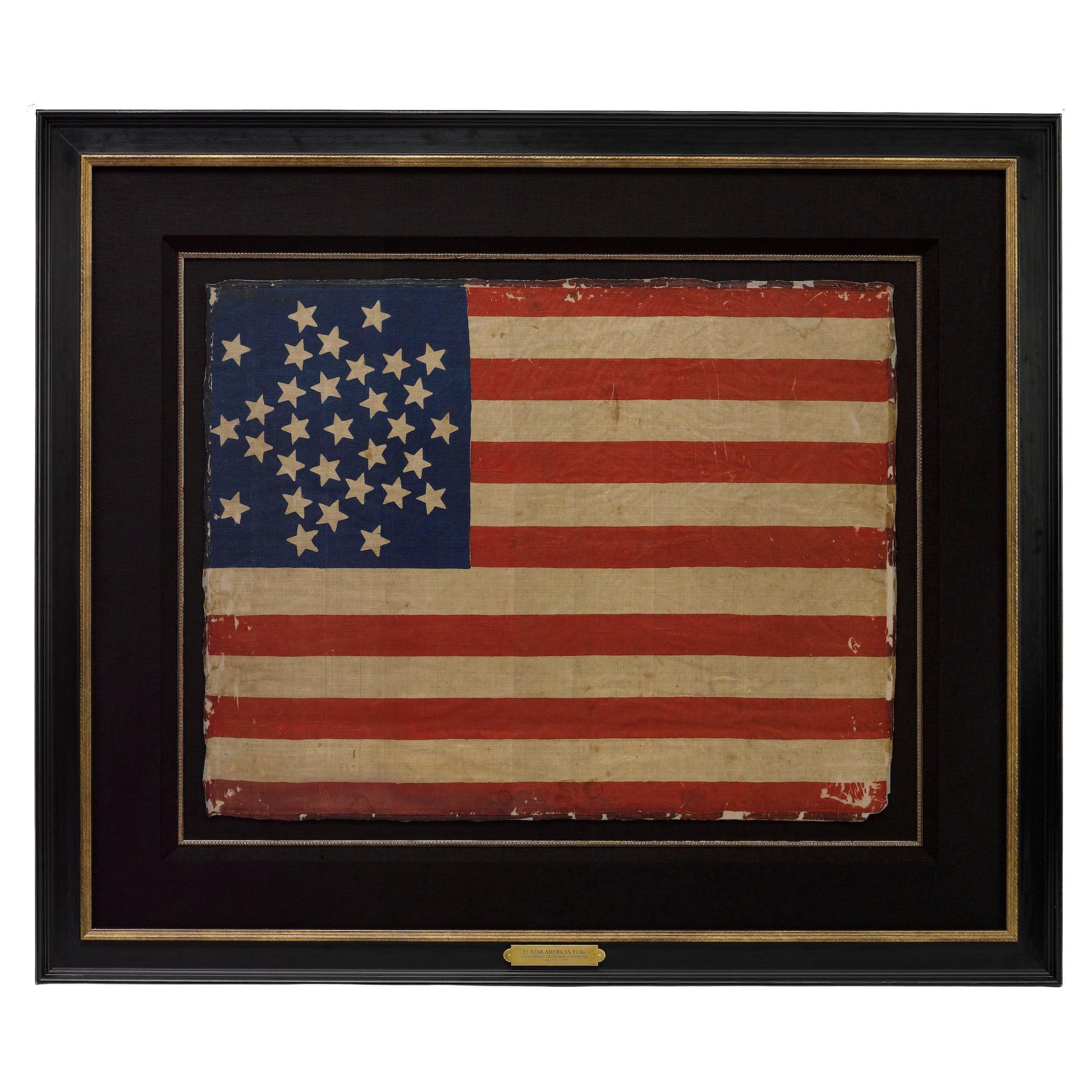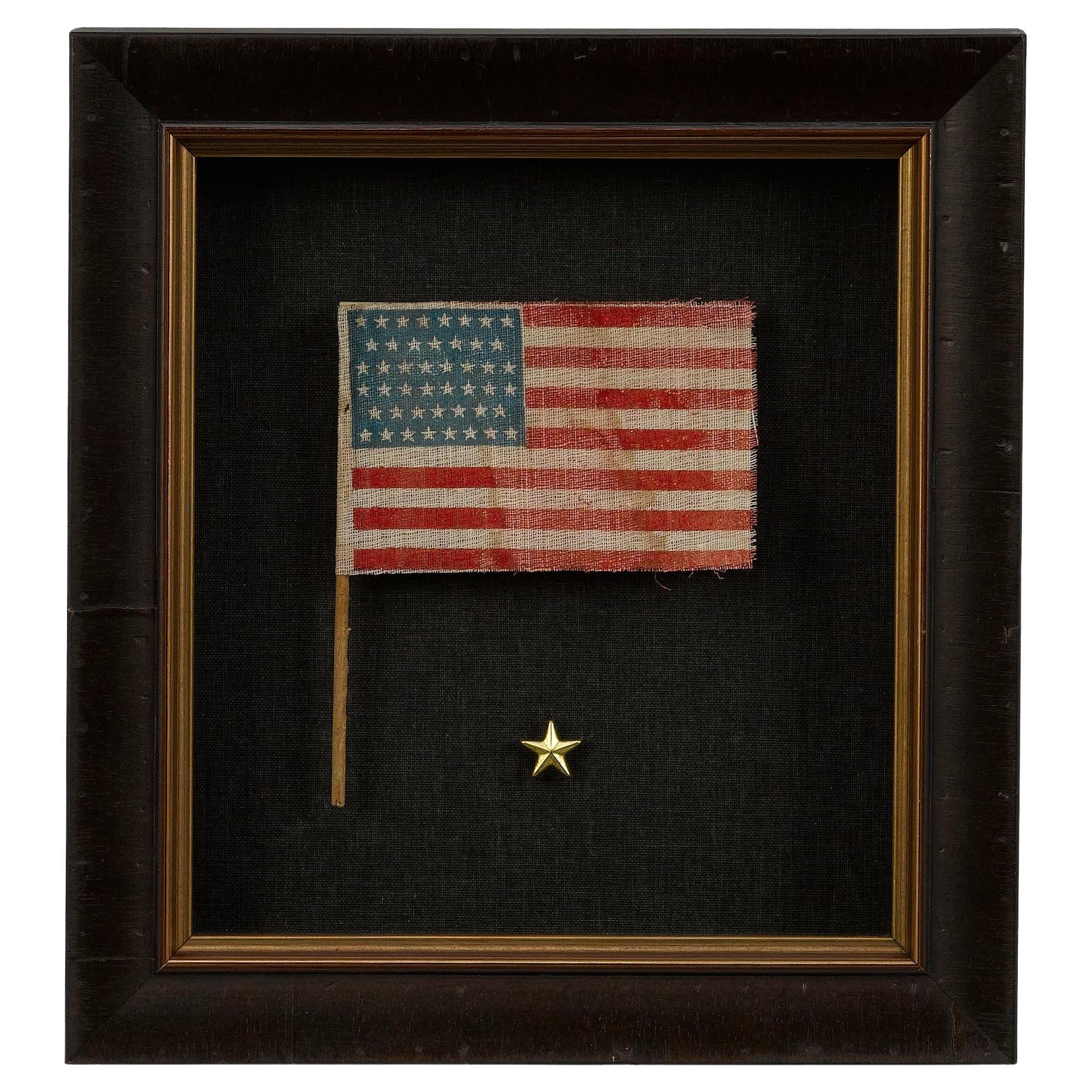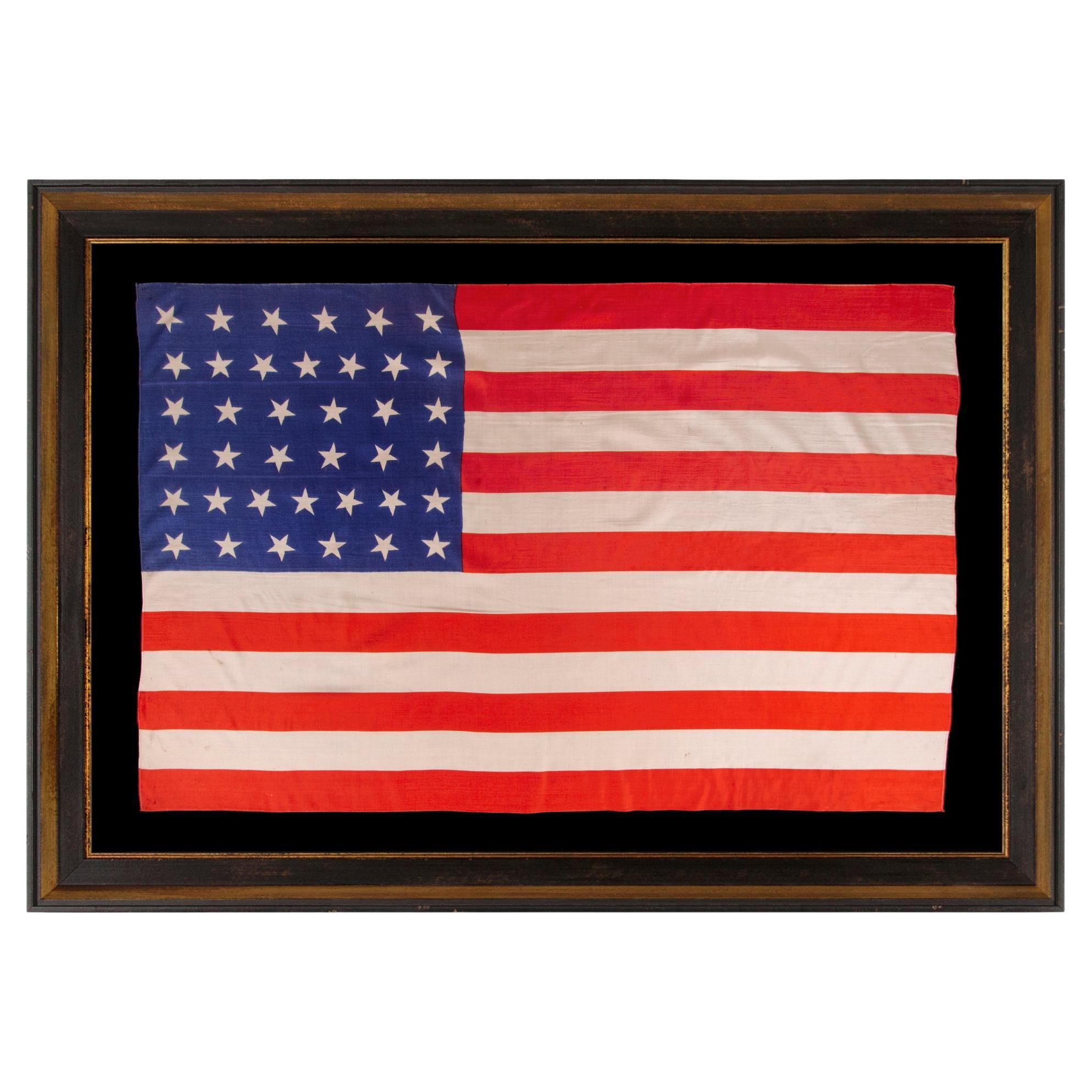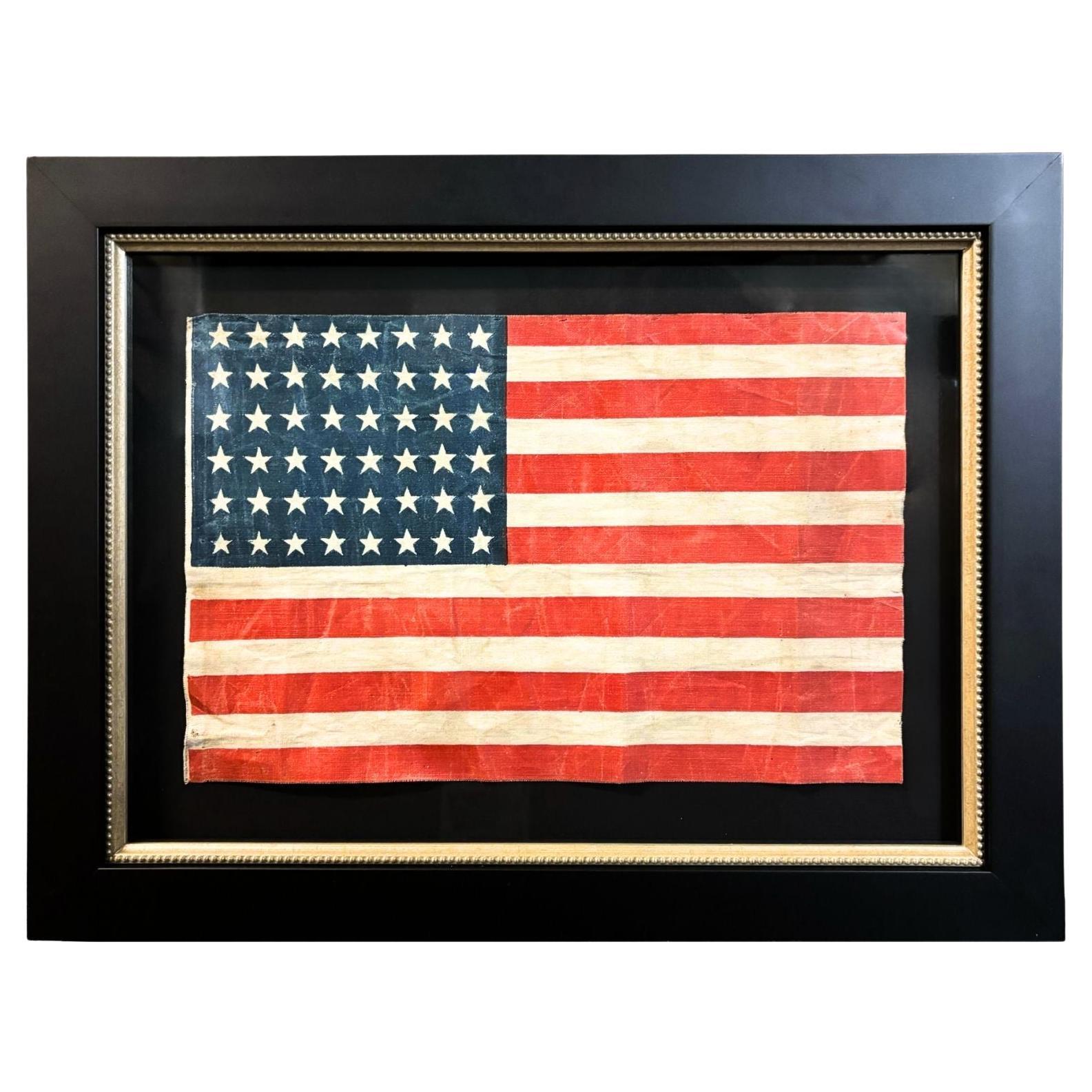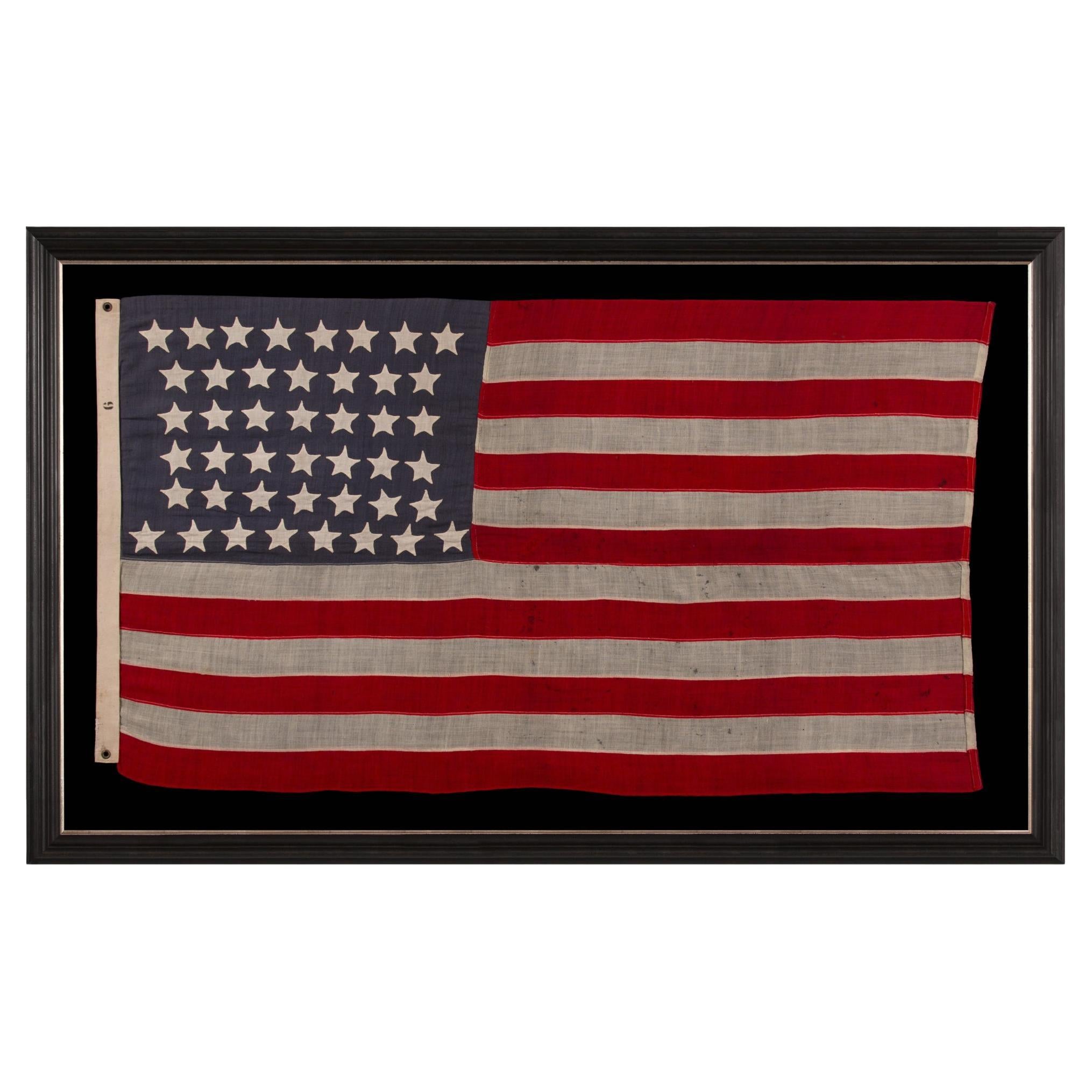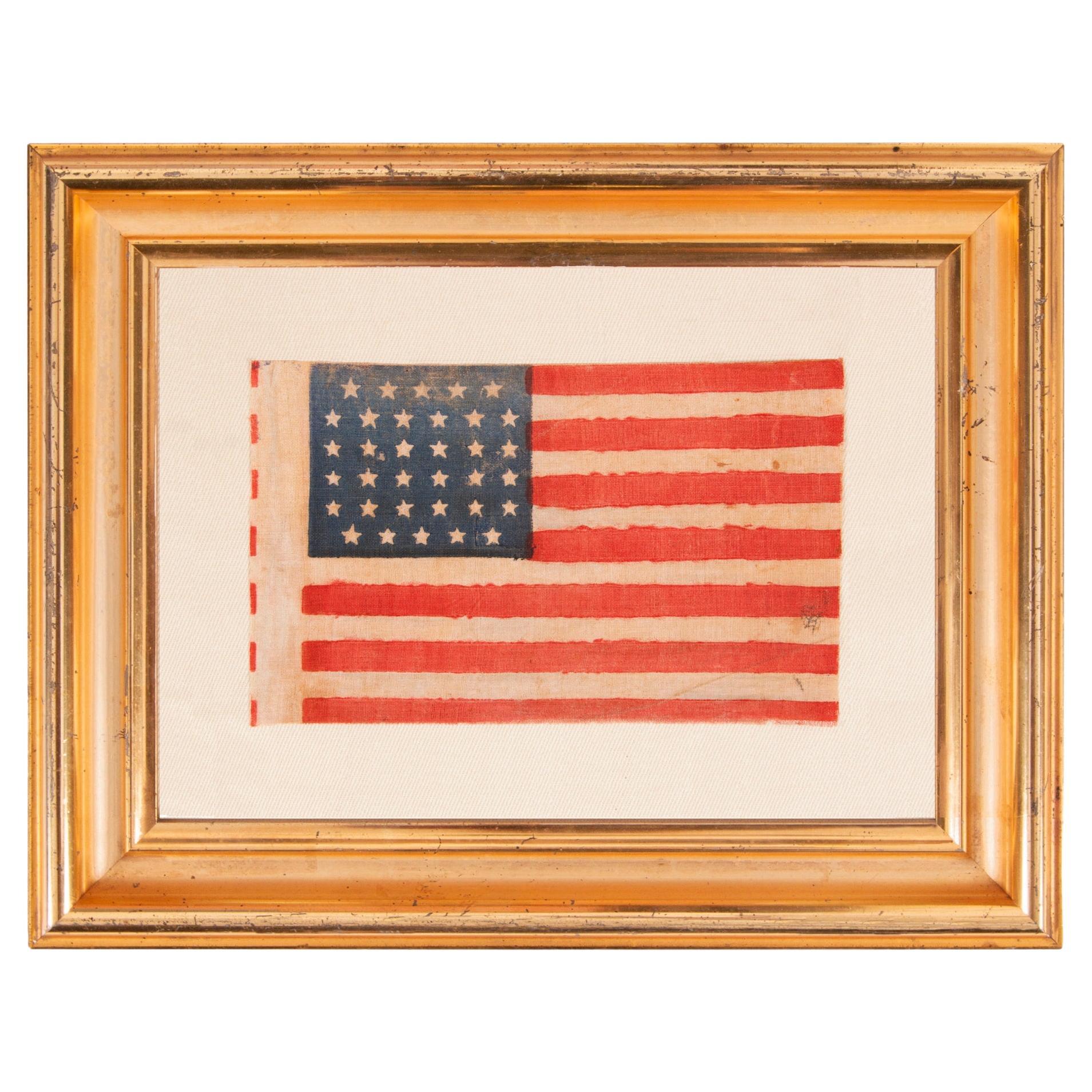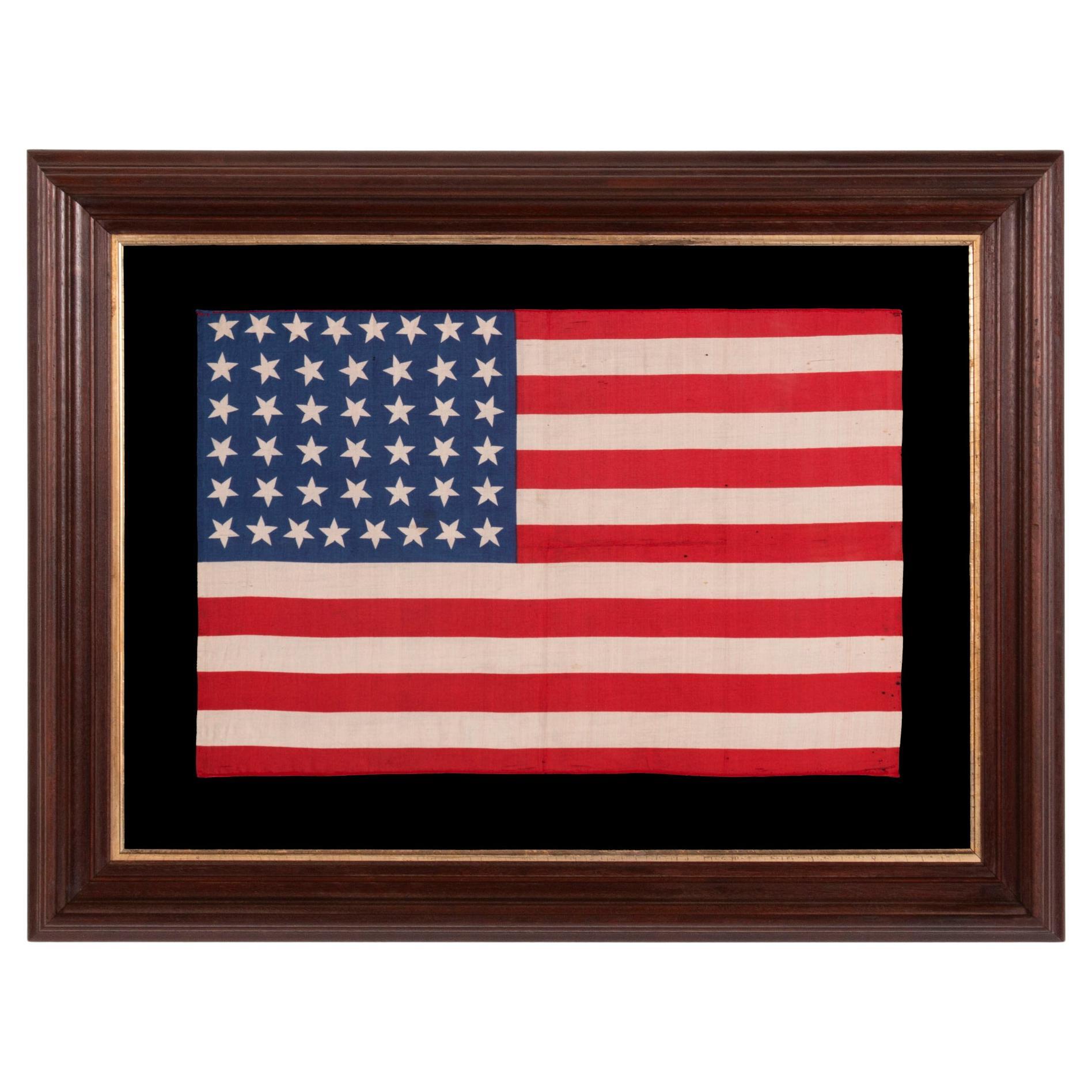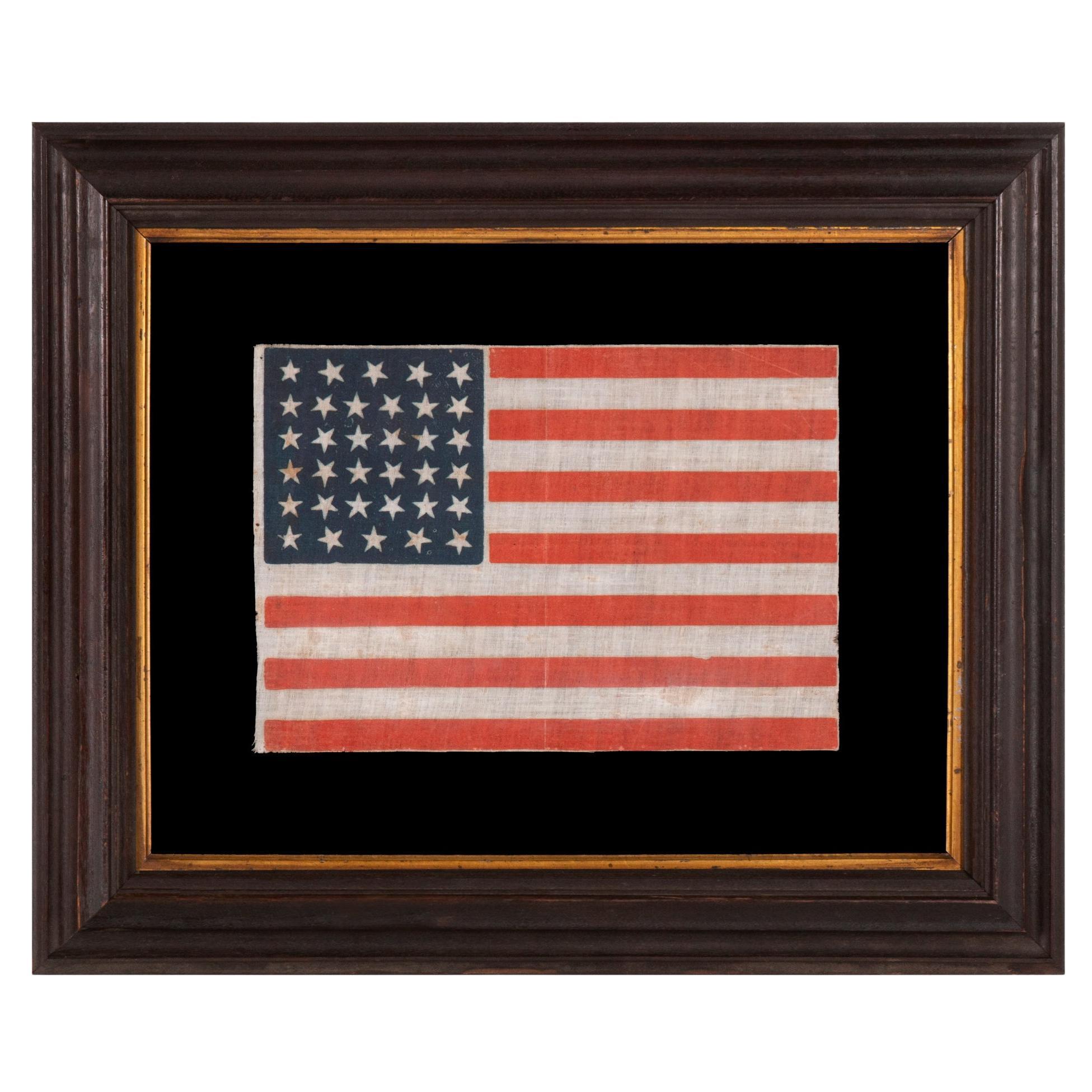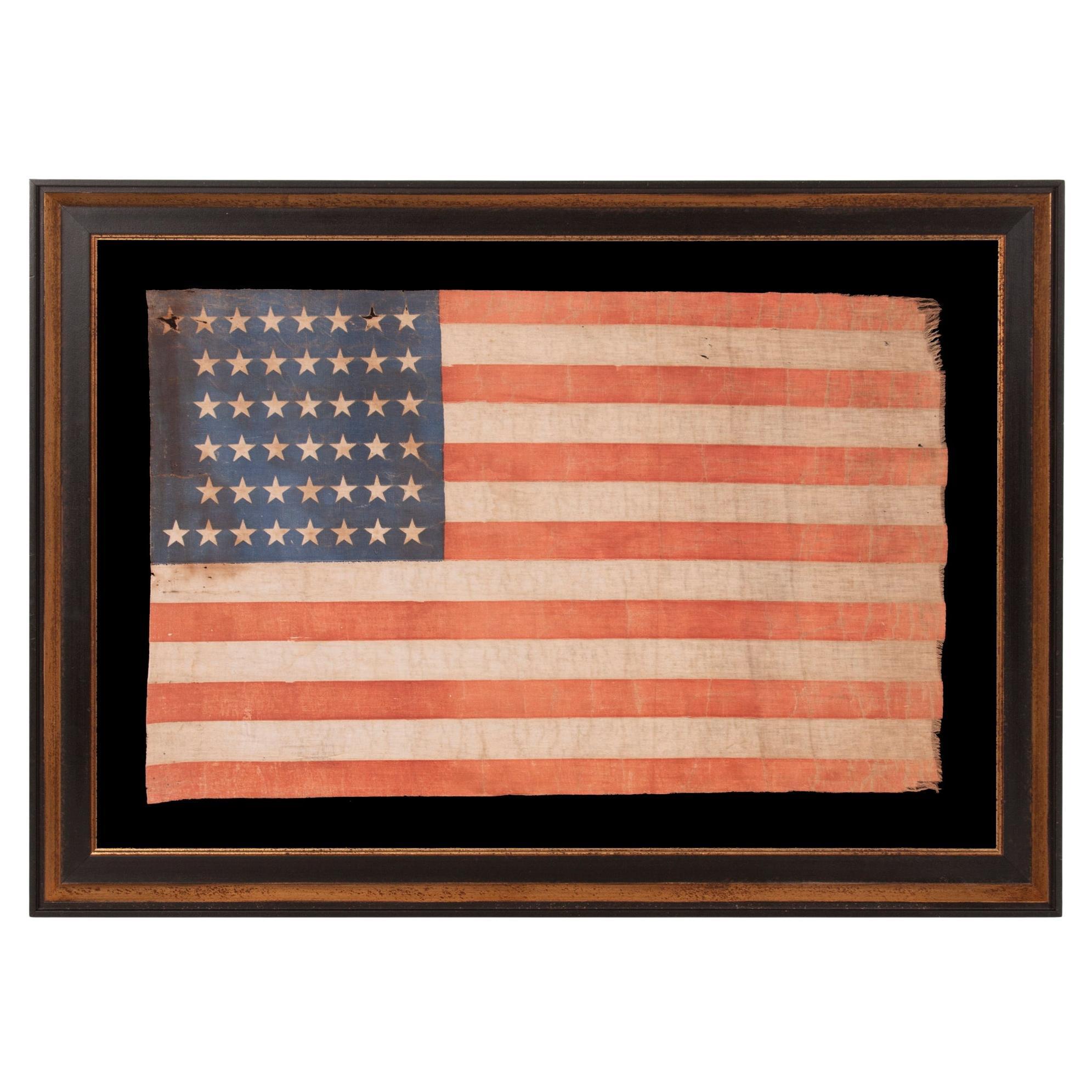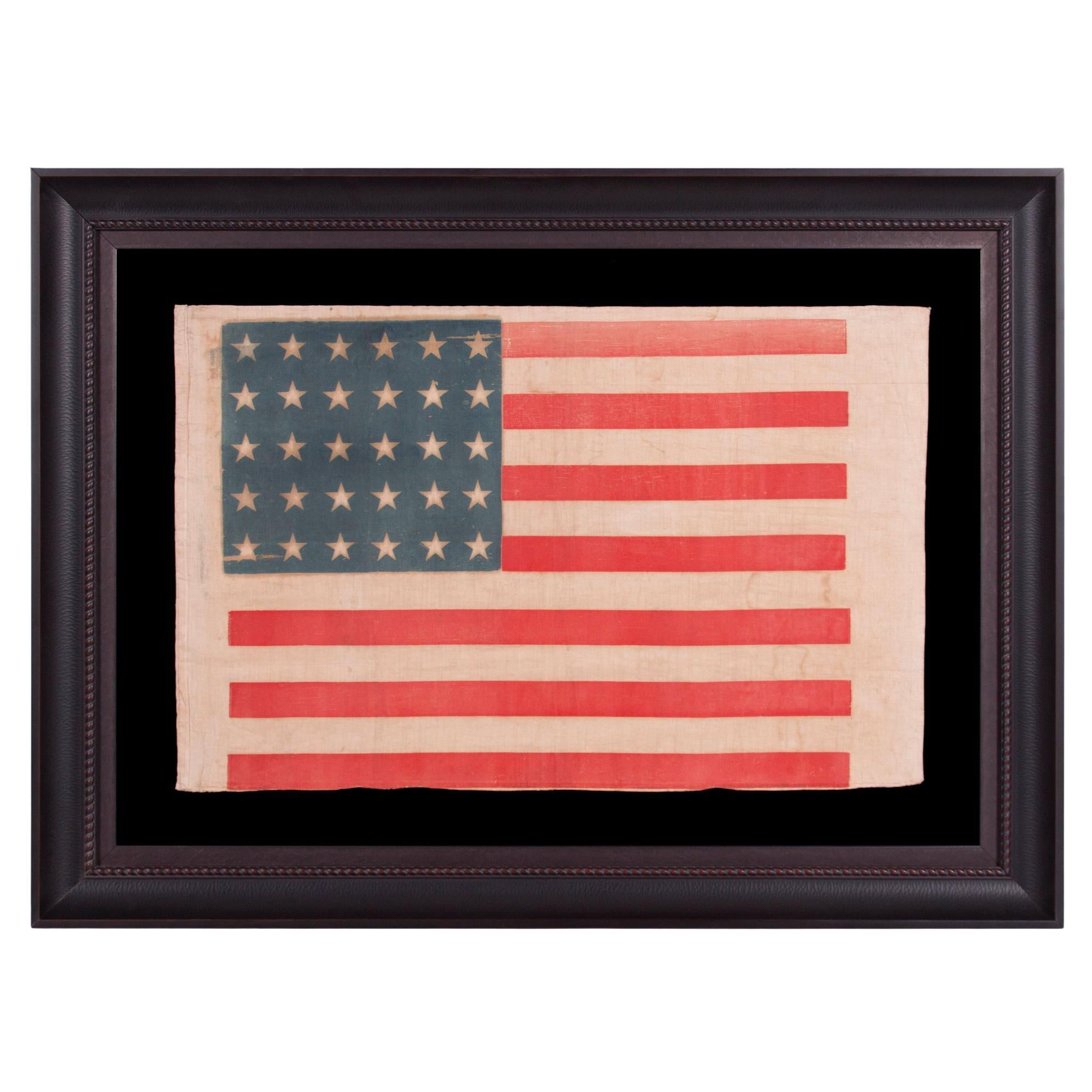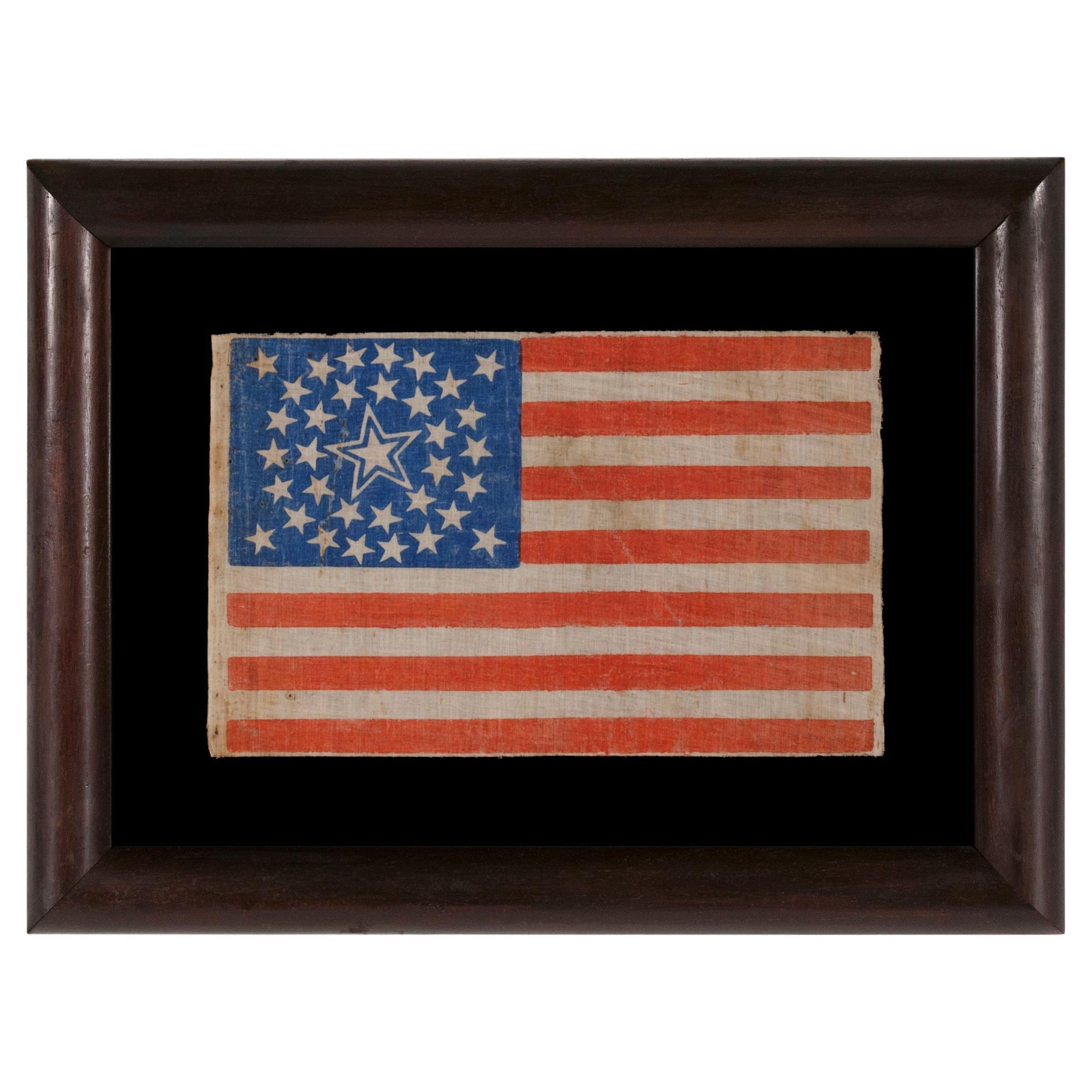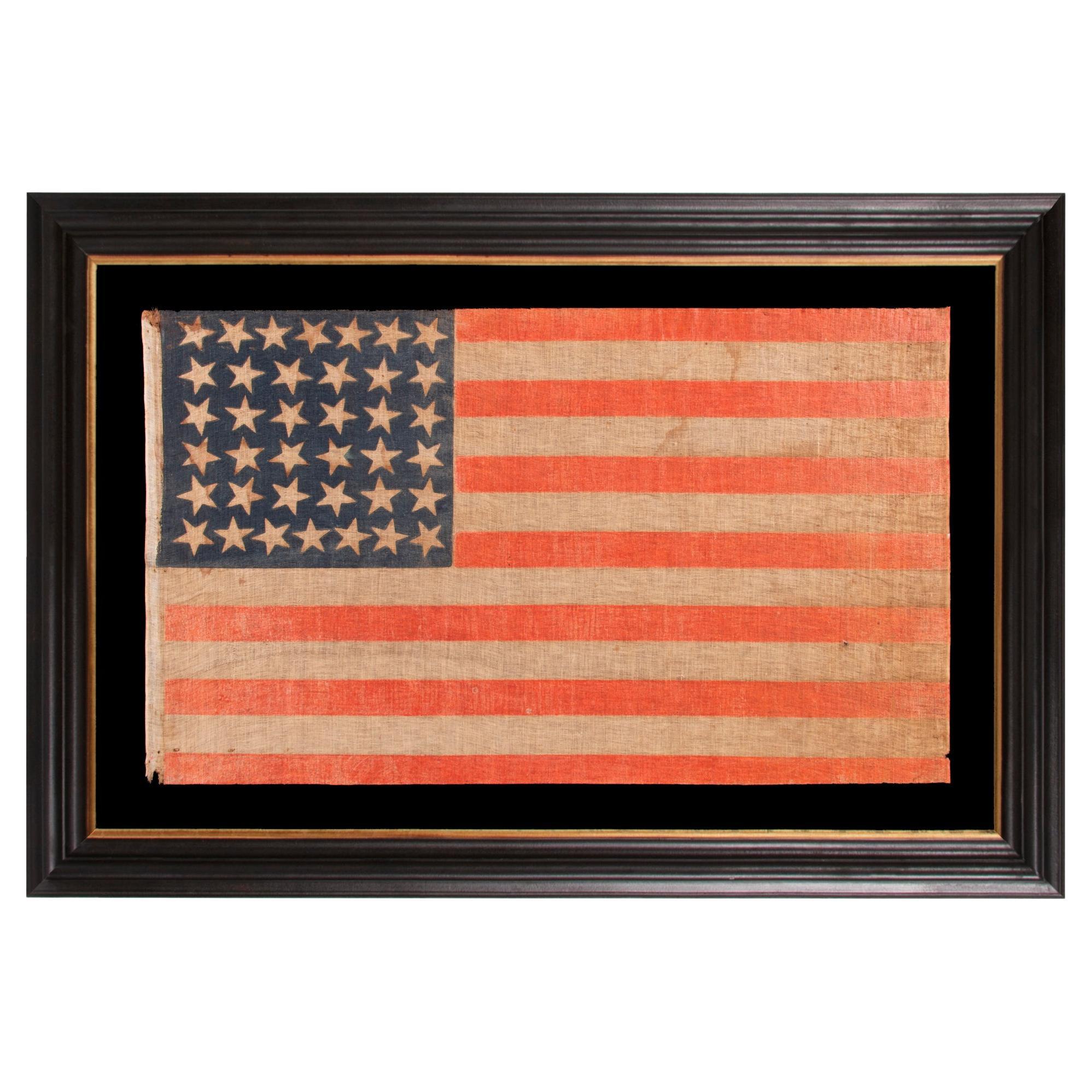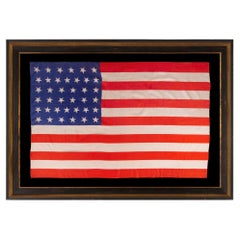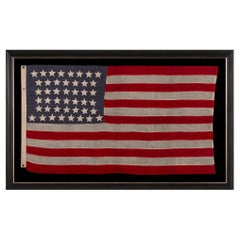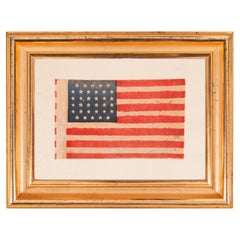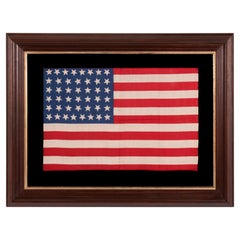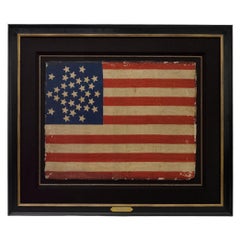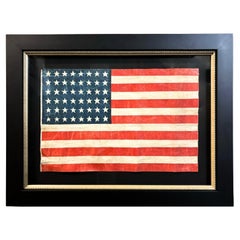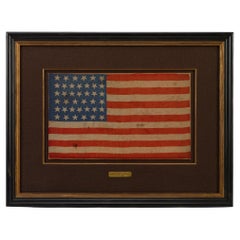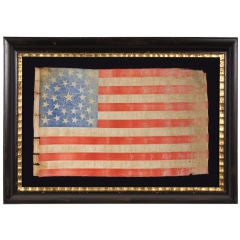
31 STAR AMERICAN FLAG, CALIFORNIA STATEHOOD, HALOED MEDALLION
View Similar Items
Want more images or videos?
Request additional images or videos from the seller
1 of 7
31 STAR AMERICAN FLAG, CALIFORNIA STATEHOOD, HALOED MEDALLION
About the Item
Note how the center star isn’t solid, but is silhouetted by a white line called a “halo”. The bold style of this star and the overall design places it among the most beautiful early patterns. Although the name of the company that made these “haloed” medallion flags is not known, it appears to have made only six different star counts using this style: 30, 31, 34, 35, 36 and 42 stars. Because printed parade flags did not exist before either 1837 or 1840, this flag maker is one of the earliest known producers.
The orange coloration is typical of many printed cotton flags made during and prior to the 1876 Centennial Exposition. I have good reason to suspect that this was the original color or certain print runs, because the color is always consistent on printed flags with orange stripes. If exposure to certain elements caused fading of the red, then flags would exist where parts are orange and parts are red. But this is not the case. The dye lots of print runs vary in color with the dye that was employed, but there are no red and orange flags with inconsistent fading.
The 31 star flag was official from 1851-1858. Flags made prior to the Civil War are extremely rare, comprising less than one percent of 19th century flags that exist in the 21st century. This is partly because, prior to the Centennial, our flag was simply not used for most of the same purposes we employ it in today. Private individuals did not typically display the flag in their yards and on their porches. Parade flags did not often fly from carriages and horses. Places of business rarely hung flags in their windows. Use of the Stars and Stripes for these purposes began to rise swiftly during the patriotism that surrounded the Civil War, but civilian use of the flag was not widespread until 1876.
Even the military did not use the flag in a manner that most people might think. The primary purpose before the Civil War was to mark ships on the open seas. While the flag was used to mark some garrisons, the flags of ground troops were often limited to the flag of their own regiment and a Federal standard. Most people would be surprised to learn that the infantry wasn’t authorized to carry the Stars & Stripes until the 1830’s, and even then did not often exercise the right, because it was neither required nor customary. It was not until the Civil War took place that most U.S. ground forces even bothered to carry the National Flag.
Mounting: The flag has been hand-stitched to 100% cotton twill, black in color. The background fabric was washed to remove excess dye, and an acid-free agent was added to the wash to set the dye. The flag was then placed in a contemporary, black painted, hand-gilded and distressed Italian molding. Spacers keep the textile away from the glass, which is u.v. protective.
Condition: The flag was obviously flown for a significant period of time and shows all evidence of the fact. There are holes along the hoist end where tacks held the flag to its staff and tears where the lowest three would have been. There is both fading and significant dye loss throughout, especially at the fly end. There is minor fabric loss at the fly end as well, plus minor to moderate foxing and staining throughout. Many of my clients prefer early flags to show their age and history of use. Further, this is a very rare example that warrants practically any condition, so long as it is presentable, and the flag presents wonderfully almost as a result of its condition issues.
- Place of Origin:
- Period:
- Date of Manufacture:1850-1858
- Condition:See item description.
- Seller Location:York County, PA
- Reference Number:Seller: 31j-8241stDibs: U0910208497177
About the Seller
5.0
Recognized Seller
These prestigious sellers are industry leaders and represent the highest echelon for item quality and design.
Established in 1991
1stDibs seller since 2008
70 sales on 1stDibs
Typical response time: 1 to 2 days
Authenticity Guarantee
In the unlikely event there’s an issue with an item’s authenticity, contact us within 1 year for a full refund. DetailsMoney-Back Guarantee
If your item is not as described, is damaged in transit, or does not arrive, contact us within 7 days for a full refund. Details24-Hour Cancellation
You have a 24-hour grace period in which to reconsider your purchase, with no questions asked.Vetted Professional Sellers
Our world-class sellers must adhere to strict standards for service and quality, maintaining the integrity of our listings.Price-Match Guarantee
If you find that a seller listed the same item for a lower price elsewhere, we’ll match it.Trusted Global Delivery
Our best-in-class carrier network provides specialized shipping options worldwide, including custom delivery.More From This Seller
View All38 Star Antique American Flag, Colorado Statehood, circa 1876-1889
Located in York County, PA
38 star antique American parade flag with scattered star orientation, made of silk, with generous scale and vivid colors, Colorado Statehood, 1876-1889
38 star American national p...
Category
Antique Late 19th Century American Political and Patriotic Memorabilia
Materials
Silk
Price Upon Request
44 Star Antique American Flag, Wyoming Statehood, ca 1890-1896
Located in York County, PA
44 STAR ANTIQUE AMERICAN FLAG WITH AN HOURGLASS ARRANGEMENT ON A DUSTY BLUE CANTON; REFLECTS THE ERA WHEN WYOMING WAS THE MOST RECENT STATE TO JOIN THE UNION, 1890-1896
Wyoming was ...
Category
Antique 1890s American Political and Patriotic Memorabilia
Materials
Wool
Price Upon Request
34 Star Antique American Parade Flag, Kansas Statehood, ca 1861-1863
Located in York County, PA
34 STAR ANTIQUE AMERICAN FLAG WITH A LINEAL ARRANGEMENT THAT I HAVE TERMED "GLOBAL ROWS, WITH EXCEPTIONAL COLOR AND CRUDE YET BEAUTIFUL FEATURES, OPENING TWO YEARS OF THE CIVIL WAR, ...
Category
Antique 1860s American Political and Patriotic Memorabilia
Materials
Cotton
Price Upon Request
44 Star Silk Antique American Flag, Wyoming Statehood, ca 1890-1896
Located in York County, PA
44 STARS IN JUSTIFIED ROWS, WITH VARIED STAR POSITIONING, ON A SILK, ANTIQUE AMERICAN FLAG WITH STRIKING COLORS, REFLECTS WYOMING STATEHOOD, circa 1890-1896
44 star American parade ...
Category
Antique Late 19th Century American Political and Patriotic Memorabilia
Materials
Silk
Price Upon Request
34 Star Antique American Parade Flag, Kansas Statehood, ca 1861-1863
Located in York County, PA
34 STARS, WITH SCATTERED POSITIONING, ON AN ANTIQUE AMERICAN PARADE FLAG MADE DURING THE OPENING TWO YEARS OF THE CIVIL WAR, 1861-63, KANSAS STATEHOOD
34 star American national flag...
Category
Antique 1860s American Political and Patriotic Memorabilia
Materials
Cotton
Price Upon Request
44 Star Antique American Parade Flag, Wyoming Statehood, ca 1890-1896
Located in York County, PA
44 STAR ANTIQUE AMERICAN PARADE FLAG WITH ENDEARING WEAR FROM LONG TERM USE AND WITH ITS STARS ARRANGED IN A NOTCHED PATTERN THAT LEAVES 4 SPACES OPEN FOR THE REMAINING WESTERN TERRI...
Category
Antique 1890s American Political and Patriotic Memorabilia
Materials
Cotton
Price Upon Request
You May Also Like
31-Star Printed American Flag, Celebrating California Statehood, Circa 1850
Located in Colorado Springs, CO
This is a rare 31-star medallion printed American flag, celebrating the addition of California to the Union. The flag is printed on silk and has a spectacular “Great Star” canton pat...
Category
Antique 1850s American Political and Patriotic Memorabilia
Materials
Silk
46-Star Printed American Flag Waver, Celebrating Oklahoma Statehood
Located in Colorado Springs, CO
Presented is an American flag waver with 46 stars. The printed flag features a row pattern of stars against a dark blue canton, with thirteen red and white stripes completing the des...
Category
Antique Early 1900s American Political and Patriotic Memorabilia
Materials
Fabric
48-Star Printed American Flag, Commemorating Arizona Statehood, 1912-1958
Located in Colorado Springs, CO
This is an original 48-star American parade flag, celebrating Arizona statehood. A wonderful product of our nation's early history, this flag is an authentic antique, with a fly date...
Category
Mid-20th Century American Political and Patriotic Memorabilia
Materials
Fabric
39-Star Printed American Flag, Commemorating North Dakota Statehood, 1889-1890
Located in Colorado Springs, CO
This is a 39-star unofficial American flag, celebrating North Dakota statehood. The printed flag dates to 1889 and showcases a “whimsical” star pattern in the canton. The flag's cant...
Category
Antique 1880s American Political and Patriotic Memorabilia
Materials
Fabric
45-Star American Flag, Printed on Cotton, Celebrating Utah Statehood, 1896-1908
Located in Colorado Springs, CO
This 45-star United States flag celebrates the statehood of Utah. 45-star flags served as the official American flag from 1896-1908. This particular flag was flown as a parade flag. ...
Category
Antique 1890s American Political and Patriotic Memorabilia
Materials
Cotton
39-Star Antique American Flag with 'Whimsical' Star Pattern, 1889
Located in Colorado Springs, CO
This is a 39-star unofficial American flag, handmade and printed on cotton. The flag dates to 1889 and has a unique history, thanks to its rare star-count.
The flag’s canton is prin...
Category
Antique 1880s American Political and Patriotic Memorabilia
Materials
Cotton
